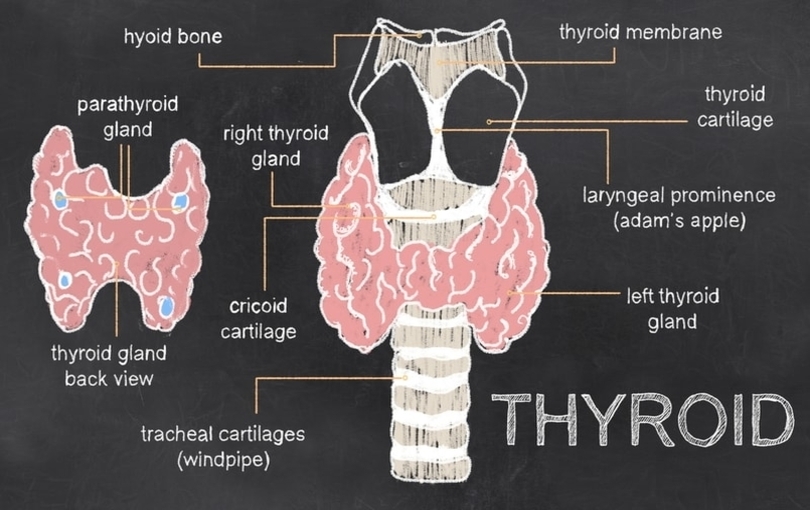Depending on the tissue or organ where the cancer begins, there are around 200 types of cancers and these are called primary cancers. Some cancers have a high likelihood of spreading from one tissue to another and this is called metastasis. Secondary or metastatic cancers are those that have spread from primary locations, the location where they have first appeared. Thyroid cancer is the cancer in the thyroid gland, an endocrine organ which produces hormones that control the speed of metabolism.

The thyroid gland:
The thyroid gland is an endocrine gland located in front of the neck below the adam’s apple and just below the larynx. It has two lobes one on each side of the windpipe joined by a narrow strip of tissue called isthmus and is hard to find by touch.
Functions:
The thyroid gland secretes hormones that are necessary for the metabolism, growth and development of the body and it uses iodine from the food we eat to make two main hormones:
- Triiodothyronine (T3)
- Thyroxine (T4)
It is important that the levels of T3 and T4 in our body are not too high or low and the pituitary and the hypothalamus glands near the brain are responsible for maintaining the levels of these thyroid hormones through a hormone called thyroid stimulating hormone (TSH).
The important body functions that the thyroid hormones regulate are:
- Breathing
- Heart rate
- Central and peripheral nervous systems
- Body weight
- Muscle strength
- Menstrual cycles
- Body temperature
- Cholesterol levels
Thyroid nodules:
Tumours in the thyroid are also called thyroid nodules and these are formed due abnormal overgrowth of cells in the thyroid gland. These are very common with at least half of the people having one nodule by the age of 60 years. 95% of the thyroid nodules are benign though and and only 5% are cancerous in nature.
What are the causes and risk factors of thyroid cancer?
The causes and risk factors of thyroid cancer are listed below.
Causes:
Thyroid cancer can be caused due to a number of inherited conditions, but the exact cause of most thyroid cancers is yet to be found though certain gene mutations have been noted in different types of thyroid cancer. Many of these have changes in specific parts of the RET gene, a gene that provides instructions for producing a protein involved in signalling within the cells. Read more about causes of thyroid cancer here.
Risk factors:
The risk factors are the conditions that suggest higher probabilities for a certain disease, in this case thyroid cancers. Presence of risk factors does not imply cancer but only indicates likelihood of developing one.
- Thyroid cancer is three times more likely in women than in men though the exact reason for this is not known.
- The peak ages for developing this cancer is around 40 years to 50 years in women and 60 years to 70 years in men.
- People with familial adenomatous polyposis (FAP) have an increased risk of papillary thyroid cancer.
- People with Cowden disease have increased risk of developing thyroid cancer, other thyroid problems and benign tumours too.
- Follicular thyroid cancer is more common in areas with low iodine in the diet, exposure to radiation in addition to low iodine can also cause papillary cancer.
- Exposure to high amounts of radiation especially in the neck region or head increases the risk of thyroid cancer, more so in children who have received radiation treatment at younger ages.
- Having a first degree relative (parent, sibling or child) with thyroid cancer increases the risk of this disease.
Know more about risk factors of thyroid cancer here.
Signs and symptoms:
Thyroid cancer does not show any symptoms in most cases and even the ones seen occur in the advanced stages of cancer. The following are the most common symptoms of thyroid cancer:
- A slow growing lump in the neck
- Swelling of glands in the neck
- Neck pain, which could extend upto the ears
- Permanent voice changes or unexplained hoarseness
- Trouble in swallowing
- Breathing troubles
- Cough and cold
- Sore throat
Know more about symptoms of thyroid cancer here.
Types of thyroid cancer:
There are five types of thyroid cancer based on the origin of the cancer.
Papillary thyroid cancer:
This is a differentiated thyroid cancer and is one the most common and slow growing thyroid cancers which develops from the follicular cells. It is often observed in one lobe, it can occur in both lobes but rarely does. The 10 year survival rate of papillary thyroid cancer is above 90%, which makes it a very curable form.
Follicular thyroid cancer:
Follicular thyroid cancer is one of the rare types that begins in the follicular cells of the thyroid gland and is a differentiated form of cancer meaning the tumour cells resemble the normal cells. This cancer has a slow growth and does not often spread to the lymph nodes.
Hurthle cell cancer:
This cancer is also known as hurthle cell carcinoma or oxyphil cell carcinoma and it develops in a particular type of follicular cells. Accounting for 3% of all types of thyroid cancer, this is a very rare type.
Medullary thyroid cancer (MTC):
Accounting for 3% of thyroid cancer, medullary thyroid cancer is a rare form of cancer but is fast spreading. If it is diagnosed and treated before it spreads to other parts of the body, it can be controlled. In almost all of the patients, the cancer is confined to the thyroid gland.
Anaplastic thyroid cancer:
This is one of the rarest type of thyroid cancers, accounting for only 1% of all the thyroid cancers. Anaplastic carcinoma has a very fast growth, and hence it spreads to the other parts of the body quickly too. Because of this reason, it is not easy to treat this type of cancer successfully. Anaplastic thyroid cancer has a very low success rate, having a 5 year survival rate of 7%.
Know more about types of thyroid cancer here.
Diagnosis:
Thyroid cancer is one of the most curable cancers if diagnosed early and treated before it gets metastasized. The following are the tests used to confirm thyroid cancer:
Medical examination:
These are exams used to check the general health along with the signs of thyroid cancer like nodules and lymph nodes along with checking for signs and symptoms in the patient.
Biopsy:
Biopsy for thyroid cancer involves the removal of cells from the suspicious areas and examining them under a microscope and this is one of the most reliable tests to confirm thyroid cancer. A fine needle aspiration involves removing of cells of the suspected region through a thin needle whereas surgical biopsy means examination of cells removed through or post surgery.
Laryngoscopy:
This test involves the checking of the larynx to check the normal functioning of the vocal cords because the thyroid tumours may press the vocal cords.
Blood hormone tests:
These tests are done to check the levels of certain hormones in the blood and abnormalities in these levels indicate a disease in the organ or tissue related to that particular hormone most important of those is thyroid-stimulating hormone (TSH).
Blood chemistry studies:
Certain blood tests are performed to check the levels of certain substances, mainly calcium that are released into the blood and abnormalities in these levels indicate certain diseases.
Ultrasound:
Ultrasound aims in producing the side of the thyroid nodules and helps in knowing if the nodules are solids or fluid-filled. Ultrasounds are used during biopsies too, to guide the fine-needle aspiration.
CAT or CT scan:
Also known as tomography, computerized tomography, or computerized axial tomography, this scan gives the detailed pictures of the organs from different angles, generated by a computer which is linked to an x-ray machine. For the scan, a dye is give to the patients intravenously or orally for the tissues to be imaged clearly.
Know more about diagnosis of thyroid cancer here.
Stages:
Staging of thyroid cancer helps the doctors figure out the on how much the cancer has spread in the body and determine its best treatment. Staging also helps calculate survival statistics. The lower the number of the stage, the less is the cancer has spread, with early stages being 1 and the most advanced stage being 4. Read more about staging of thyroid cancer here.
Staging:
Cancer types that form tumours are staged using TNM system and the same method is used for thyroid cancer too. The size of the primary tumour (T), the presence of cancerous lymph nodes (N) and how far the thyroid cancer has spread to a different part of the body (M) can be described using the TNM system.
Other factors:
Type of thyroid cancer and age are important factors for determining the stage too, differentiated thyroid cancers are staged differently than medullary and anaplastic cancers.
Differentiated thyroid cancer refers to those types in which the cancerous cells look and act like normal thyroid cells, and this accounts for more than 90% of all thyroid cancers. Papillary and follicular thyroid cancers are differentiated with the former accounting to 80% of the total cases and the latter, 10%.
Age is also taken as a factor for staging differentiated thyroid cancers while it is not a factor for medullary thyroid cancer, this is because younger patients are less likely to die of differentiated cancers than older patients.
All anaplastic thyroid cancers are staged to be stage IV due to the poor diagnosis of this cancer type and the exact stages will be discussed in the treatment of stage IV of thyroid cancers.
Treatment methods:
The course of treatment is decided based on the type and stage of thyroid cancer and the patient’s age and response to treatment. The following are the treatment options available to treat thyroid cancer:
Surgery:
This is the most common treatment option for thyroid cancer and the surgeries available to treat thyroid cancer are as follows:
- Lobectomy: Removal of the lobe in which thyroid cancer is detected and is preferred if the cancer shows no signs of spreading beyond the thyroid gland.
- Thyroidectomy: This is the most common surgery used in treating thyroid cancer and has the advantage of monitoring for recurrence through radioiodine scans. If the entire thyroid gland is removed, it is called total thyroidectomy and if not it is called near total thyroidectomy.
- Lymph node removal: If the cancer has spread to nearby lymph nodes in the neck, they are removed at the same time as the surgery and this is an important treatment method for anaplastic and medullary thyroid cancers.
Know more about surgery for thyroid cancer here.
Radiation therapy:
Radiotherapy involves killing cancer cells using high intensity radiation and is also used if the tumours are to be targeted unlike chemotherapy which kills cancer cells in all body parts. This is one of the most common treatments given to patients who are not recommended for surgical procedures or for recurring thyroid cancers.
Know more about radiotherapy for treating thyroid cancer here.
Radioiodine therapy:
This treatment involves using a radioactive form of iodine to kill the cancer cells in thyroid cancer. The thyroid gland absorbs all the iodine in the body so only the thyroid cells are damaged with little effect on the other parts of the body. It destroys any thyroid tissue not removed by the surgery or is used to kill cancer cells that have spread to lymph nodes and other organs. It is also used to treat recurrent thyroid cancer but cannot be used to treat anaplastic and medullary thyroid cancers because these types of cancers do not react to iodine. Know more about radioiodine treatment for thyroid cancer here.
Chemotherapy:
Chemotherapy uses drugs to kill cancer cells throughout the body and is used if the thyroid cancer has metastasized to other organs or if there is a chance of recurrence. It can be used both before the surgery and after as an adjuvant therapy. For patients with anaplastic thyroid cancer, chemoradiation (radiation given along with chemotherapeutic drugs) is the recommended treatment option. Know more about chemotherapy for thyroid cancer here.
Thyroid hormone therapy:
After thyroidectomy or other surgical procedures for treating the cancer, the patient’s blood samples will be tested for the levels of hormones, particularly the TSH. Depending on these results, thyroid hormone medication may be prescribed to the patients.Patients are often recommended to continue this medication for a long-time post treatment, sometimes even for life.
Targeted therapy:
This treatment uses medications that target specific cancer cells in the body. They aim at the signs of growth and division of the cancer cells. It is often recommended to patients with advanced thyroid cancer. The most common drugs used are:
- Cabozantinib
- Sorafenib
- Vandetanib
Know more about treatment options for treating thyroid cancer here.
Follow up care with thyroid cancer:
Follow-up care is very important in the patients who completed their thyroid cancer treatment. They should see the doctors regularly. The patient’s new symptoms and problems are to be notified to the doctor immediately. The follow-up care includes the following:
Personal care:
The patients should maintain a good health by consuming a healthy diet, maintaining a healthy weight, avoiding tobacco smoking, limiting the consumption of alcohol. More importantly the patients should follow the guidelines given by the doctors.
Medical tests:
Doctors may regularly perform some medical tests in follow-up care of the patients who are surviving after thyroid cancer treatment. They do some blood tests like level of TSH suppression and thyroglobulin level.
Physical examination:
After completing the thyroid cancer treatment, doctors will monitor the patients recovery for the months and years. The patients are asked to come for a followup to visit the doctor for every six months or one year. Doctor examines the patients physically.
Breast cancer screening:
Women patients who are treated for follicular or papillary thyroid cancer may have a high risk of developing breast cancer. Mammography is a standard screening method for breast cancer. Women who survive thyroid cancer should have frequent mammographic screening and breast examination for breast cancer.
Know more about concerns after thyroid cancer treatments here.
Tests for side effects (long-term):
There may be a possibility of secondary cancer as a long-term side effect in the patients who are treated for thyroid cancer.
Other Tests:
- Thyroid scan
- Chest x-ray
- Neck ultrasound
- CT scan
- PET scan



